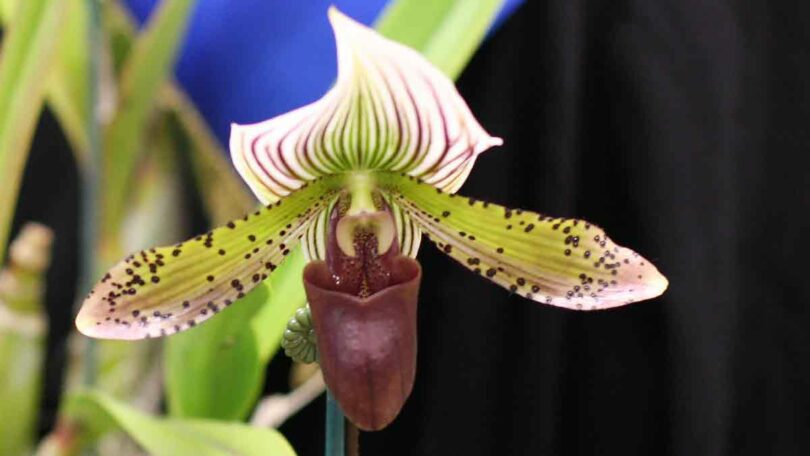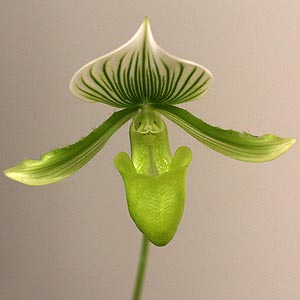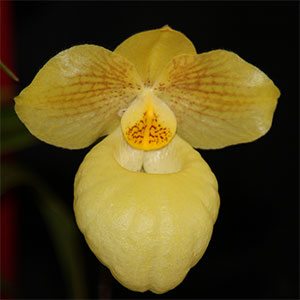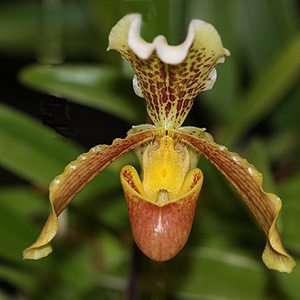Slipper Orchids

Paphiopedilum Orchid species ‘Slipper Orchids’ or ‘Paphs’ are originally from South China , India and Southeast Asia with unusual flowers they are sometimes called ‘lady slippers’.

A well lit situation but avoiding full sun. Use a good orchid growing mix, some growers place pots on trays of pebbles sitting in water to help maintain humidity.
They are reasonably easy to grow, depending on species and are one of the most popular orchids for the home gardener.
Paphiopedilum Orchids – Care
Constant moisture, but not water logged is the key, bright filtered light is the best, they will even grow on a windowsill, but not direct sun.
The temperature is the tricky part, some are cool growing, other like warmth, so ask questions when buying.
- Light:
These are a low light orchid, no direct sun, however reasonably bright light. If the leaves stat to develop redness, then that’s too much light.
If the leaves are really deep green and the plants don’t flower it’s not enough light.
So medium green leaves is the best indication of the right amount of light.
Try passing your hand over the foliage, it should not cast a distinct shadow.
You can grow them in a glasshouse with 50 – 75 % shade depending on your climate, the hotter, the heavier shade. - Temperature
Indoors, if you feel comfortable with temperature, then the Paphs will generally be comfortable as well. So around 20c. The extremes 5c – 30c - Humidity
Try for around 60% humidity or a range from 40-70% humidity. - Growing Medium/Potting Mix
Use a pine bark potting medium, it works well with Paphs.
4 parts of medium bark to fine.
Use fine bark for young plants, Medium for established plants.
1 part of perlite,
1 part of charcoal
Into that you could add a little rock dust type fertiliser such as Gro-Max which is a Microbe and Rock Mineral Fertiliser, or a little blood and bone. - Pots
Pot to size of the root system, when dividing do not make very small divisions - Watering
Paphiopedilum orchids require regular watering, however frequency of watering depends on the growing medium as well as the climate.
In a bark based orchid mix, which will be naturally free draining, watering will be every 4 – 7 days depending on the mix itself and the temperature.
In a more moisture retentive mix, with sphagnum moss or similar, watering will be less frequent. Wait until the growing medium begins to dry a little.
Overwatering is a major problem as it causes root problems, fungal disease and rot.
Water sparingly in winter and always ensure a free draining potting mix - Repotting
Repot every two years to refresh the potting mix, this ensures that salt build up is removed and the potting mix that is beginning to break down and slow drainage is replaced. - Fertilizer
Fertilize regularly with a weak 50% solution rather than all at once with a strong one. It is best to fertilise more when in active growth and cut back over winter, however in warmer climates they will grow a little over winter as well. - Buying Paphiopedilum Orchids
Plants should be purchased from reputable growers, you are looking for a good root system and signs of active growth, glossy foliage
Top Tips For Paphiopedilum Orchids
- Good air circulation helps prevent disease, so don’t crowd them together with other plants.
- After flower, cut off the old flower spike. Fertilise and water.
- The best time to repot is immediately after flowering.
- Keep them away from windows and heating/cooling ducts.
Paphiopedilum Hybrids

The many Paphiopedilum hybrids available for sale fall into a number of categories and these are a little confusing as different growers and even some orchid societies seem to use different terms.
Plants that are a cross between two different species are perhaps the easiest to deal with, these are sometimes referred to as a ‘primary cross’ or ‘first cross’ after this the world of hybridisation becomes a little murky to any but the specialist.
Paphiopedilum maudiae is perhaps the best known hybrid of all, it is a cross between the two species Paph . callosum sanderae x Paph. lawrenceanum hyeanum and this was back in the late 1890s. P.micranthum is a much sought after species.
Pictured right is Paphiopedilum maudiae magnificum, large flowers and one of the best green and white Paphs going around. A fairly good grower and actually very nice mottled foliage as well.
You can buy Paphiopedilum Orchids from the following growers
Large variety of Epimediums, Woodland plants and Herbaceous perennials
Mail order or nursery. We do not send to Tasmania or WA
www.cloverhillrareplants.com
More Information
So why do the Paphs, or ‘Slipper Orchids make such good house plants ?
They like low light, warmth and with some moisture and indirect light near a window they do well. Yes they will do better in a greenhouse, but not everyone can do this.

Species to look for
- P.sanderianum is a spectacular yet rarely seen species, its a tropical species from Borneo, the long petals hang down like two tresses for nearly 1m
- P. rothschildianum is more well know, in fact it is commonly called the ‘King of Paphs’, large flowers and again from Borneo.
- P.insigne is from Northern India through to the Himalayas, a cooler growing species and a little easier for most home growers.
- P. venustum is another cooler growing species and is on of the first brought into cultivation
Available for sale from the following nurseries
Large variety of Epimediums, Woodland plants and Herbaceous perennials
Mail order or nursery. We do not send to Tasmania or WA
www.cloverhillrareplants.com
More than One Slipper Orchid Species.
Four different Orchid species are commonly called Slipper Orchids :
- Cypripedium (These are terrestrial orchids from Asia, Japan, Europe and North America)
- Selenipedium (These are terrestrial orchids from Central and South America)
- Phragmipedium (Both epiphytic and lithophytic, from South America)
- Paphiopedilum (These grow as terrestrial, epiphytic and lithophytic and are found across Asia).

